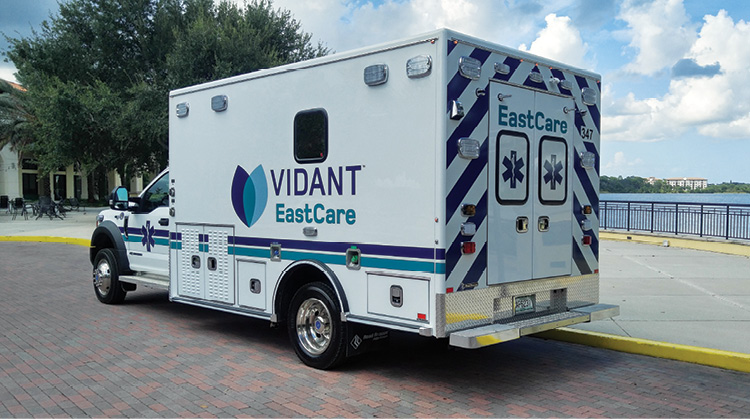
Alan M. Petrillo
Eastern North Carolina has quick access to a Level I Adult Trauma Center and a Level II Pediatric Trauma Center at Vidant Medical Center in Greenville, North Carolina, where a multidisciplinary team of trauma specialists provides the highest level of trauma care for patients.

An important part of Vidant’s emergency, trauma, and critical care services is Vidant EastCare, its air and ground medical transport service. Depending on a patient or victim’s location, they may be taken to a regional hospital and transferred to Vidant Medical Center or transported directly from the scene of the injury or illness by Vidant EastCare.
Vidant EastCare operates 22 ground ambulances throughout eastern North Carolina, including one dedicated to the Children’s Transport Team. Vidant also operates five helicopters located in five different counties. Both ground and air ambulances run by Vidant EastCare provide rapid transportation and advanced medical care to critically ill and injured patients to tertiary care centers, says Scott Sampey, administrator for Vidant EastCare.
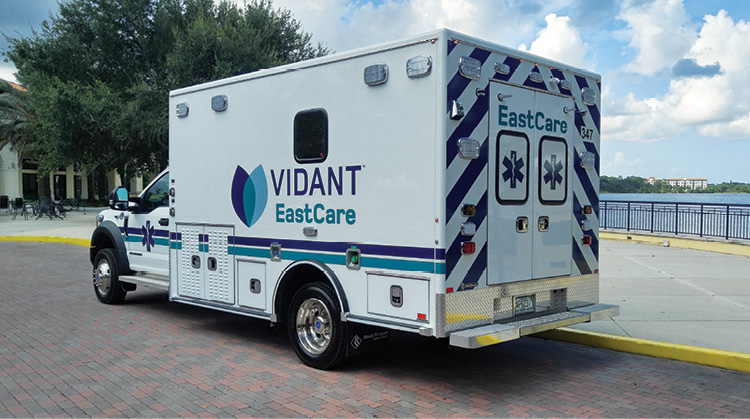
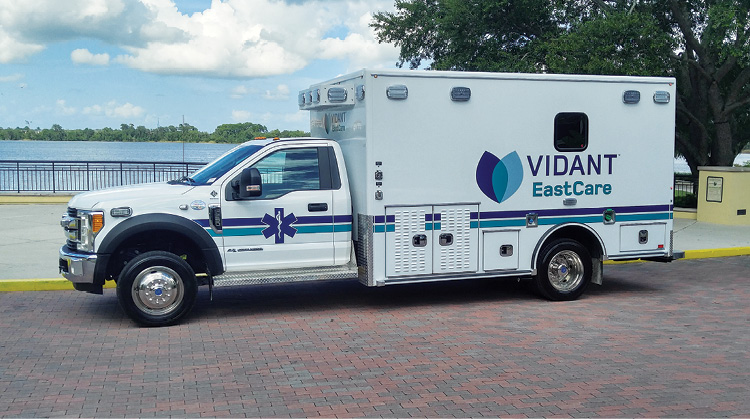
1 REV Group built three Road Rescue Ultramedic 4×2 ambulances for Vidant Health’s Vidant EastCare, North Carolina, on Ford F-550 chassis with pass-through long bodies. (Photos courtesy of Atlantic Emergency Solutions.) 2 The Road Rescue rigs for Vidant EastCare are powered by 6.7-liter turbo diesel engines and have a 193-inch wheelbases, overall lengths of 25 feet three inches, and overall heights of nine feet five inches.
REPLACEMENT NEED
Vidant Health recently wanted to replace ambulances in its fleet and chose REV Group to build three Road Rescue Ultramedic 4×2 ambulances with the Ferno iNTRAXX Integrated Vehicle Component System™ inside the patient box, Sampey notes. “Our 120 staff members, consisting of registered nurses, paramedics, and emergency medical technicians (EMTs), are all trained for critical care transport, and we are accredited by the Commission on Accreditation of Medical Transport Systems (CAMTS),” he says. “Our ambulances are driven by EMTs and in the back are either a paramedic or a registered nurse (RN). Sometimes, if it’s a neonatal intensive care unit trip, we would have both a paramedic and an RN in the back.”
department
Vidant EastCare (NC), Vidant Health
Strength: 120 paid staff consisting of registered nurses, paramedics, and EMTs; eight ground bases; five helicopter bases.
Service area: Vidant EastCare is the hospital transport system for Vidant Health’s Vidant Medical Center serving a 29-county area in eastern North Carolina and handling emergency hospital to hospital transport, helicopter 911 emergency calls, and ground mutual aid with other agencies when requested.
Other apparatus: 22 Type 1 ambulances, mostly Wheeled Coach; four Eurocopter EC145 and two Eurocopter EC135 helicopters.
INTRAXX
Sampey notes that Vidant Health wanted a full iNTRAXX system across all the interior walls on its new rigs. “We wanted the safest interior we could have so we don’t have a single cabinet in the box,” he says.
Rod Scearce, REV Group’s special project manager for iNTRAXX and ZERO RPM, says the system’s three main benefits are safety, flexibility, and efficiency. “The system is primarily focused on keeping the medic seated,” Scearce says. “Instead of cabinets, labeled pouches are attached to the tracks, so a medic doesn’t have to stand up and try to find a piece of equipment.” The iNTRAXX modular system uses wall-mounted tracks that secure a series of SafeMount Equipment Mounts, SafeCab Storage Cabinets, and SafePak Supply Bags, he adds, noting that the system is designed to secure loose equipment and utensils, which allows the medic to sit strapped and provide patient care from a secure, flexible environment.
“They did a full iNTRAXX build, so they have a lot of flexibility in where they place equipment inside the patient box,” Scearce says. “Rick (Chiavichien) and the Vidant people knocked it out of the park with these rigs. This is the best, well-thought-out ambulance design that I’ve seen.”
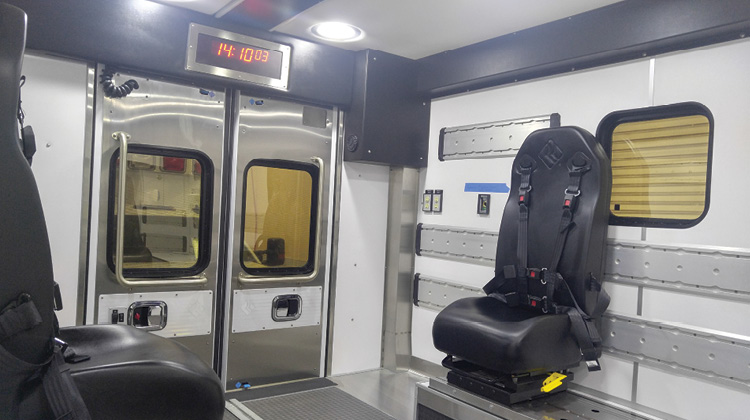
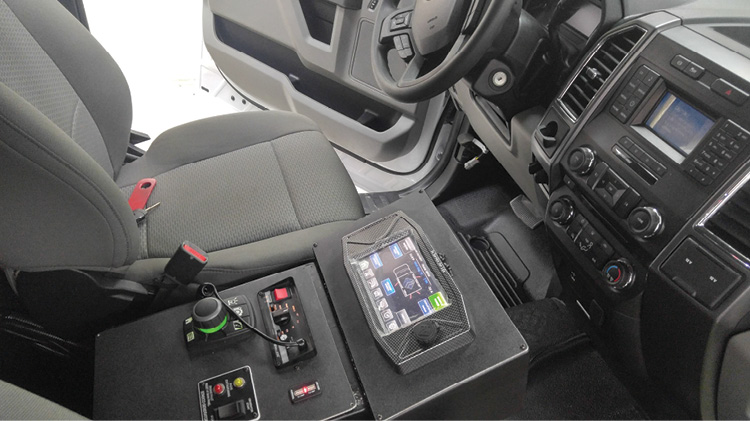
3 Headroom in the REV Group Road Rescue ambulances built for Vidant EastCare is 72 inches. 4 The driver’s cockpit on the Road Rescue ambulances.
specs
REV Group Road Rescue Type 1 Ambulances
- Road Rescue Ultramedic 4×2 ambulance on Ford F-550 chassis with pass-through long bodies
- 6.7-liter turbo diesel engines
- 193-inch wheelbases
- 25-foot 3-inch overall lengths
- 9-foot 5-inch overall heights
- 72 inches of headroom in patient boxes
- 17- by 17-inch window pass-throughs from cabs to patient boxes
- 7-kW Stadco CP7 generators
- Ferno iN∫LINE Fasteners with Ferno IN/X stretchers
- Ferno iNTRAXX Integrated Vehicle Component Systems™ throughout all interior walls
- Backup and blind spot cameras
- Three 180-degree rotating captain’s chairs on sliding tracks in patient boxes
Scearce adds that by using the iNTRAXX Integrated Vehicle Component System, “the speed and ease of deconning and restocking the truck is phenomenal.”
Sampey says that because the iNTRAXX system is a new concept for Vidant Health, the three Road Rescue ambulances run out of the service’s main base. “We have a certain group of people who use them every day, so we could trial what they liked and didn’t like about the system,” he notes. “We got very good feedback from them and are ordering two more Road Rescue ambulances with the full iNTRAXX Integrated Vehicle Component System in them. We put 100,000 miles a year on each of our ambulances, where a typical trip is two hours each way, so we want the rigs to be as safe and efficient as possible.”


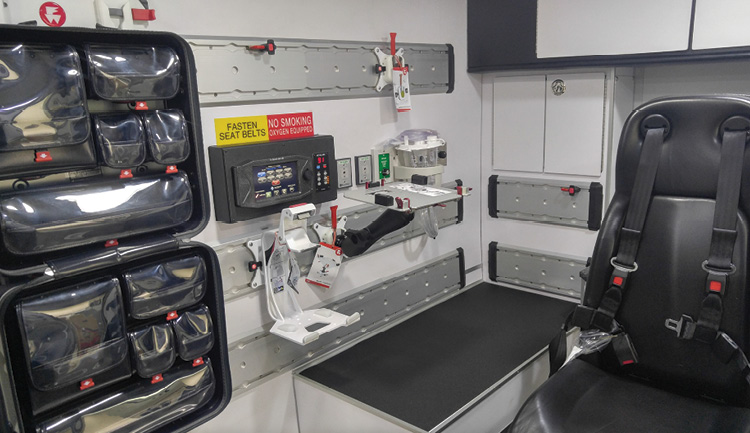
5 Vidant Health had REV Group install Ferno’s iNTRAXX Integrated Vehicle Component System™ on all the interior walls of the Road Rescue ambulances. 6 There are three captain’s chairs in the ambulances’ patient boxes, each capable of 180-degree swivel and able to slide forward and back on a track in the floor. This view is of the curbside interior. 7 One captain’s chair sits at the head of the patient cot.
AMBULANCE SPECS
Rick Chiavichien, regional accounts manager for Atlantic Emergency Solutions, who sold the three Road Rescue ambulances to Vidant Health, says the identical rigs are built on Ford F-550 chassis with a pass-through long body powered by a 6.7-liter turbo diesel engine. Each rig has a 193-inch wheelbase, is 25 feet three inches long and nine feet five inches tall, and provides 72 inches of headroom in the patient box. There’s also a 17- by 17-inch window pass-through from the cab to the patient box to allow better communication between the driver and the medic in the back.

8 The iNTRAXX system allows flexibility for where equipment is placed in the patient box and also allows a medic to sit strapped and still provide patient care in a safe environment.
Chiavichien says the rigs have three captain’s chairs, one on each side of the patient cot and one at the head, that rotate 180 degrees and slide in tracks alongside the cot. The box has a Ferno iN∫LINE fastening system, a Ferno IN/X stretcher, a 7-kW Stadco CP7 generator, a backup camera, and blind spot cameras on the wings.
Chiavichien notes that REV installed the Stadco generator in a low cabinet on the driver’s side to maximize space at the floor level. Likewise, on the opposite side of the truck, the rig’s oxygen tank and backboard storage are located in a tall cabinet on the far front section of the passenger side. “By pushing all that storage to the front of the box, we were able to give Vidant Health a patient box with flat walls and no protrusions at all,” he says. “They even were able to secure their interaortic balloon pump and their extracorporeal membrane oxygenation (ECMO) machine to the iNTRAXX system along the wall.”
ALAN M. PETRILLO is a Tucson, Arizona-based journalist, the author of three novels and five nonfiction books, and a member of the Fire Apparatus & Emergency Equipment Editorial Advisory Board. He served 22 years with the Verdoy (NY) Fire Department, including in the position of chief.

